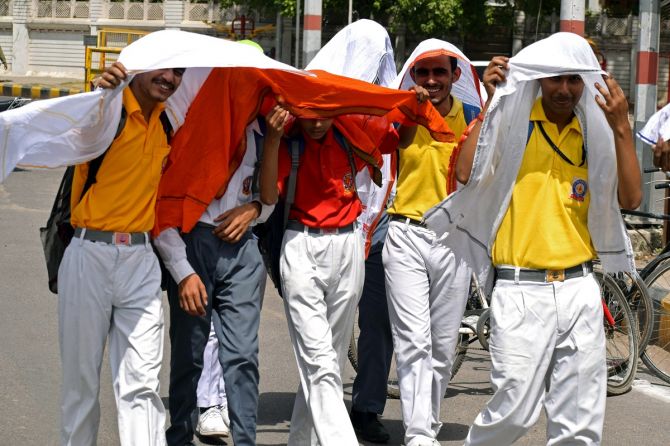Amid a punishing heatwave building up in large parts of India, Delhi saw a jump of two to three degrees Celsius in the maximum temperature at most places on Wednesday.

The Safdarjung Observatory -- Delhi's base station -- recorded a maximum temperature of 41.5 degrees Celsius as against 40.8 degrees Celsius on Tuesday.
Pitampura (43.6 degrees Celsius) and Mungeshpur (44.1 degrees Celsius) reeled under a searing heatwave.
The weather stations at Najafgarh, Ridge, and Sports Complex recorded their maximum temperature at 43.7 degrees Celsius, 43.6 degrees Celsius, and 44.2 degrees Celsius, respectively.
The mercury at the Safdarjung Observatory is expected to breach the 43-degree mark on Thursday and touch 44 degrees Celsius by Friday, according to the India meteorological department.
The maximum temperature may even leap to 46 degrees Celsius in parts of Delhi, a met department official said.
Delhi may also see a partly cloudy sky, light rain, and a dust storm with winds gusting up to 50 kmph on Friday and Sunday, which may provide a temporary respite.
The capital had recorded a maximum temperature of 43.2 degrees Celsius on April 21, 2017. The all-time high maximum temperature for the month was 45.6 degrees Celsius on April 29, 1941.
The city has recorded eight heatwave days in April this year, the maximum since 11 such days witnessed in the month in 2010.
Delhi falls in the Core Heatwave Zone -- the most heatwave-prone areas in India -- along with Telangana, Andhra Pradesh, Himachal Pradesh, Uttarakhand, Haryana, Uttar Pradesh, Rajasthan, Madhya Pradesh, Maharashtra, Bihar, Chhattisgarh, and West Bengal.
Northwest India has been recording higher than normal temperatures since March last week, with weather experts attributing it to the absence of periodic light rainfall and thundershowers, which typify this time of the year, due to the lack of active western disturbances.
The region had got some respite last week owing to cloudy weather due to the influence of a western disturbance over Afghanistan.
A yellow alert warning has been issued for a heatwave spell in the national capital starting April 28.
The IMD uses four colour codes for weather warnings -- green (no action needed), yellow (watch and stay updated), orange (be prepared) and red (take action).
The IMD said the heatwave could lead to "moderate" health concerns for vulnerable people -- infants, the elderly, people with chronic diseases -- in affected areas.
"Hence, people of these regions should avoid heat exposure, wear lightweight, light-coloured, loose, cotton clothes and cover the head by use of cloth, hat or umbrella etc," it said.
For the plains, a heatwave is declared when the maximum temperature is over 40 degrees Celsius and at least 4.5 notches above normal.
A severe heatwave is declared if the departure from normal temperature is more than 6.4 notches, according to the IMD.
Based on absolute recorded temperatures, a heatwave is declared when an area logs a maximum temperature of 45 degrees Celsius. A severe heatwave is declared if the temperature crosses the 47-degree mark.
The weather department had earlier said that northwest India and adjoining parts of central India are likely to see more intense and frequent heatwave conditions in April.
India recorded its warmest March in 122 years with a severe heatwave scorching large swathes of the country last month. Parts of the country are also seeing wheat yields drop by up to 35 per cent due to the unseasonal heat.
Dileep Mavalankar, director, Indian Institute of Public Health Gandhinagar said: "People need to watch out for IMD advisories, stay indoors, keep themselves hydrated and rush to the nearest health centre if they feel moderate signs of heat-related illness."
"There's a special need to monitor the old and vulnerable, just like we did during COVID-19 as they can develop heat strokes even when sitting at home," he said.
Mavalankar said that cities should monitor all-cause mortality data daily along with data for hospital admissions and ambulance calls to compare it with the last five years of data to get a real indication of heat stress on mortality.
The early heatwaves have a higher rate of mortality since adaptation and preparedness is lower during the months of March and April.
"The central, state and city governments should also focus on this, especially when IMD alerts are in orange and red and they should put out warning advertisements in newspapers, TV and radio to warn the public. This is a warning signal for what is to come in May and June," he cautioned.
"If we take effective action now, we can prevent a lot of morbidity and mortality," the IIPHG director said.










